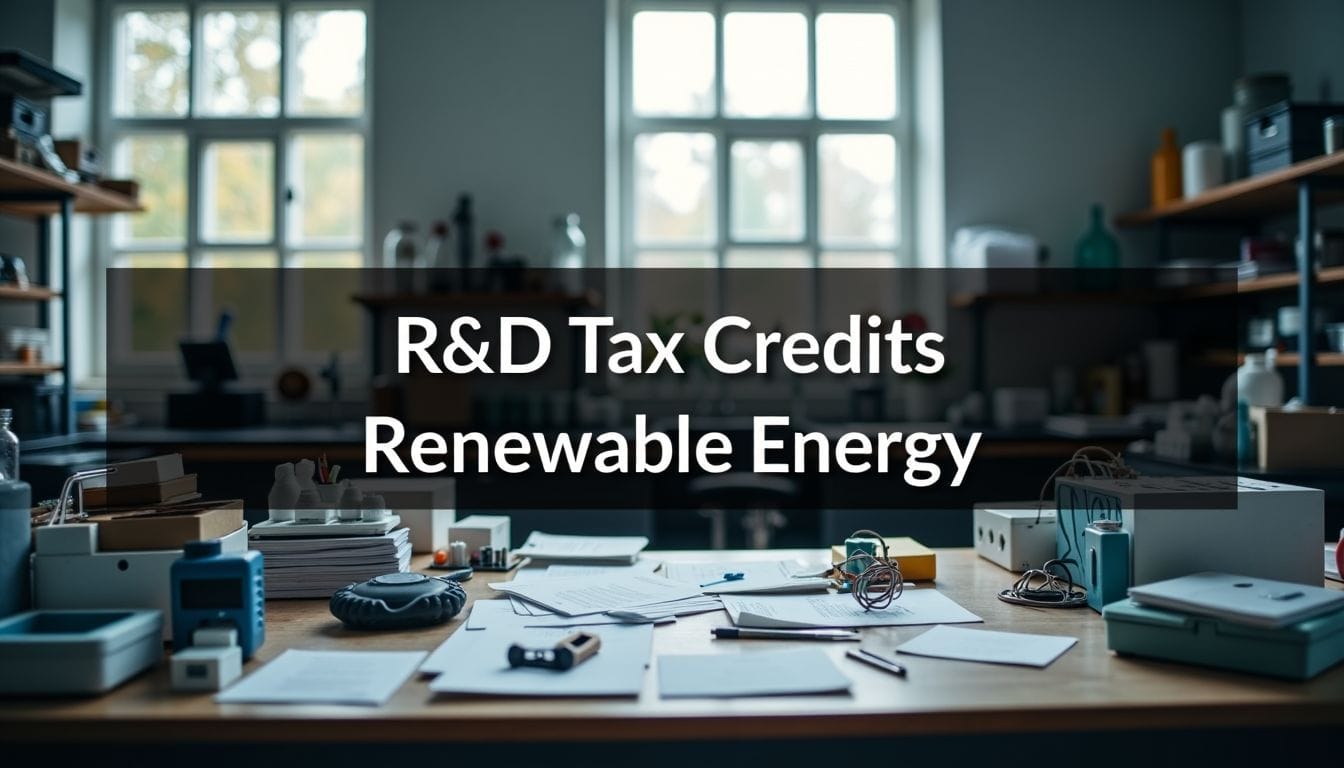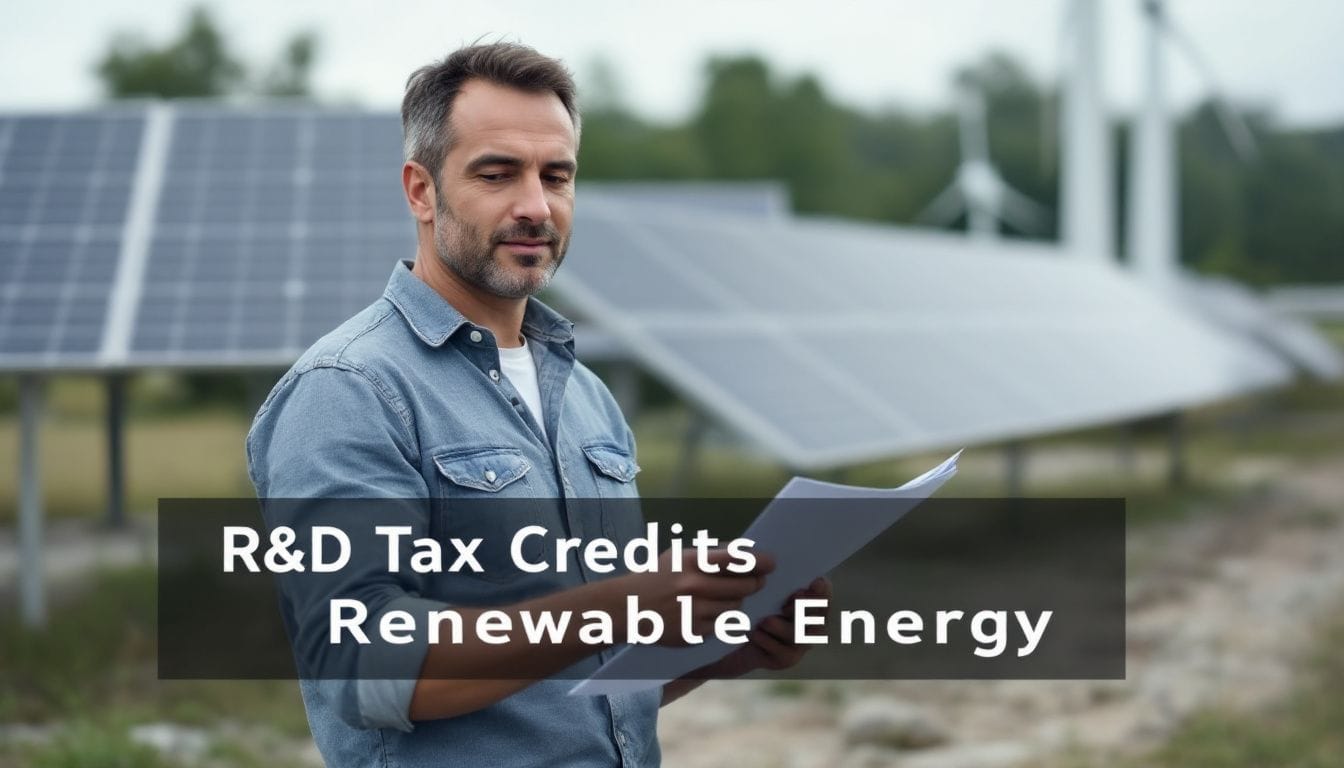R&D Tax Credits Renewable Energy
Are you a renewable energy company struggling to fund your innovative projects? You’re not alone. Many firms in the UK face challenges in financing their green initiatives.
Did you know that renewable energy now makes up 28% of global electricity supply? That’s a big jump from just 20% in 2011. Good news for the planet, but it means more competition for you.
RD Tax Credits UK can help. We’ll show you how to claim R&D tax credits for your renewable energy projects. These credits can give your business a much-needed cash boost.
Ready to power up your finances? Let’s get started.

What Are R&D Tax Credits?
R&D tax credits are cash rewards for UK firms that create new stuff. You can get money back for work on fresh products, services, or ways of doing things.
Definition and Purpose
Tax credits for research and development are a UK scheme to boost new ideas. They give money back to firms that invest in fresh tech. You can get up to 27% of your costs back through this plan.
These credits aim to make the UK a top spot for science and tech. They help firms take risks on new work. You can use the money to pay less tax or get cash. This extra money can fund more research or help your firm grow.
To get these credits, you must pay UK tax on your firm. You can claim for staff pay, stuff you use, and computer programs. You can also claim for people you hire to help and for testing new drugs.
The goal is to back firms that try new things in their field.
Eligibility Criteria
To get R&D tax credits, your project must push science or tech forward. It’s not about normal work – you need to tackle real science or tech snags. This means trying new things, even if they don’t always work.
Your firm’s size matters too. SMEs – that’s firms with under 500 staff and less than €100 million turnover – get special help. From April 2023, if you’re an SME and spend at least 40% of your money on R&D, you can claim a 14.5% tax credit rate.
This boost helps small firms keep up with big ones.
Keep in mind, not all fields count. The arts and humanities are out. But if you’re in tech, drugs, or green power, you’re on the right path. Keep good notes of your work and costs – it’ll make claiming much easier.
With the right project and proper papers, you could get a nice bit of cash back.

How Do R&D Tax Credits Apply to Renewable Energy?
R&D tax credits boost green energy projects. You can claim for work on solar panels, wind turbines, and other clean power tech.
Qualifying Activities in Renewable Energy
You can get tax credits for many green energy projects. These credits help pay for work in different areas.
- Solar cells: Make panels work better or find new materials.
- Wind turbines: Build better blades or quieter systems.
- Energy storage: Create longer-lasting batteries or new ways to store power.
- Bioenergy: Find new ways to turn waste into fuel.
- Geothermal: Get more heat from the earth.
- Water power: Make better turbines or dams.
- Wave power: Build new tools to use ocean energy.
- Tidal power: Make systems to use tides.
- Fuel cells: Make them work better or find new materials.
- Smart grids: Find better ways to manage green energy.
If you work on these things, you might get money back from the government.
Types of Renewable Energy Projects
Many types of renewable energy projects can qualify for R&D tax credits. Here are some key ones:
- Solar Energy: Work aims to make solar panels better and store more power. This includes improving solar cells, heat systems, and batteries.
- Wind Power: Projects try to make wind turbines and farms work better. They look at blade stuff, sea-based setups, and how to link to the power grid.
- Hydroelectric: Efforts focus on getting more power from water. This covers dam designs, tidal systems, and river power makers.
- Geothermal: These use heat from inside the Earth. Work looks at better ways to drill and swap heat.
- Biomass: These turn plants and waste into fuel or power. Studies look at better burning and ways to use waste for energy.
- Hydrogen Fuel Cells: Work tries to make this clean fuel more useful. They study how to make, store, and move hydrogen.
- Wave and Tidal: These use sea power. Projects make new turbines and try to guess wave patterns.
- Energy Storage: This field is vital for green power. Work includes better batteries and big power storage systems.

What Benefits Do R&D Tax Credits Offer to Renewable Energy Companies?
R&D tax credits can boost your company’s cash flow. They help you invest more in green tech and stay ahead in the market.
Financial Incentives
Tax credits for research can give big money boosts to green energy firms. On average, you can claim up to £170,132. Some even get as much as £1.8 million. These credits help pay for new tech and projects.
They’re a key way to fund growth in clean energy. So far, the UK government has given £81 million to support this field. This money helps firms stay strong when growth costs a lot.
These credits can lower your tax bill or give you cash back. This means more money to put into your business. It’s good for you and good for the planet. The credits work for many areas like sun, wind, and water power.
They can cover staff costs, materials, and even some power bills. It’s a clever way to make your green projects cost less.
Competitive Advantages
Tax credits for research can give your firm a big boost. They help you save money and make more profit. This means you can spend extra on new ideas. You’ll keep ahead of others in your trade.
Your business can grow quicker and get stronger.
These credits let you take risks on new work. You can try new tech without worry. This could lead to big steps forward. Your firm might lead the way in clean power. You’ll stand out and bring in more clients.

Which Renewable Energy Technologies Qualify for R&D Tax Credits?
R&D tax credits cover a wide range of green tech. You can claim for work on solar panels, wind turbines, and more.
Solar Energy Innovations
Solar power is expanding rapidly. In 2023, it constituted 5.5% of global electricity. Advancing technology is improving solar panels’ efficiency and affordability. Companies are developing methods to increase panel yields, resulting in greater power output from the same area.
Research and development in solar energy concentrates on innovative designs. These aim to enhance sunlight capture and conversion to power. Some concepts involve specialised coatings and novel materials.
Others explore methods to store solar energy for nighttime use. These initiatives contribute to combating climate change and reducing greenhouse gas emissions.
The UK encourages solar R&D through tax incentives. This supports companies in investing in new technology. It can cover expenses such as staff salaries and materials. Firms can reclaim up to 33% of their expenditure.
This incentive aids the UK in progressing towards its net-zero targets by 2050.
Wind Power Advancements
Wind power tech keeps getting better. Turbines now reach higher and catch more wind. They’re also smarter, using AI to adjust for weather. New materials make blades lighter and stronger.
This means more power from less wind. Offshore wind farms are growing fast too. They use floating platforms to access deeper waters.
R&D in wind power is crucial. It helps cut costs and boost output. Companies can claim tax credits for this work. These credits cover things like new blade designs or better control systems.
They also apply to testing new materials or improving wind forecasting. RD Tax Credits UK can help you get these benefits.
Hydroelectric Developments
Water power plays a big role in clean energy. It made up 14.3% of the world’s power in 2023. That year, the world could make 1,267.9 GW from water. This shows how much we count on water for power.
Research on water power aims to make it work better. New turbine designs can make more power. Smart tech helps control water flow better. These new ideas make water power kinder to nature.
They also help it work well with other clean power sources.
Geothermal Research
Scientists are looking into the Earth’s heat for clean power. They want to find new ways to drill deeper and get more energy. They study how to use hot rocks and water to make power.
This work helps the heat-from-Earth industry grow.
Right now, the world can make 14.9 GW of this power. That’s less than 1% of all power made. But experts think it can grow. They look at better ways to drill and new places to get heat.
These could help us use more Earth heat to fight climate change. Tax breaks can help UK firms do this key work.

How Can Companies Claim R&D Tax Credits for Renewable Energy Projects?
You can claim R&D tax credits for renewable energy projects by keeping good records and filling out the right forms… Want to know more?
Documentation Requirements
From 1 August 2023, new rules apply for R&D tax credit claims. You must get papers ready for each project. These include details of the top officer and any agents who help. Clear records make the claim process smoother.
Good paperwork is key to winning R&D tax credit claims. Keep track of all project costs, staff time, and research results. Good records make it easier to show HMRC how your work fits the tax relief rules.
Application Process
Claiming R&D tax credits is easy. Follow these steps to get your benefits:
- Check if you can claim: Make sure your work fits what HMRC calls R&D.
- Get your facts: Collect all costs that matter, like wages and supplies.
- Work out your claim: Add up all the R&D costs you can use.
- Fill in forms: Do the CT600 and other papers you need.
- Send your claim: Give it to HMRC within two years of your account year end.
- Wait for them to look: HMRC often takes 28 days to check claims.
- Answer questions: Reply fast if HMRC asks you anything.
- Get your money: Once they say yes, you’ll get tax relief or cash.

What Are the Recent Changes in R&D Tax Credits for Renewable Energy?
Recent changes to R&D tax credits for renewable energy aim to boost green tech… Want to know more? Read on!
Policy Updates
Big changes have come to R&D tax credits in the UK. From April 2023, the RDEC rate went up from 13% to 20%. This helps big firms put more money into green tech.
For small firms, things are not the same. The extra tax break dropped from 130% to 86%. The credit rate also fell from 14.5% to 10%. These changes aim to stop people from misusing the system.
A new single plan starts on 1 April 2024. It will work like RDEC for all firms. This update aims to make claims easier and more fair. It could help more firms get tax relief for their green energy work.
Future Outlook
The future looks good for R&D tax credits in green energy. The UK wants to get more private money into eco-friendly tech. This means more help for solar, wind, and other clean power projects.
You’ll likely see bigger tax breaks for firms working on green answers.
Experts think clean energy R&D claims will go up a lot. As the UK tries to reach zero emissions, tax perks will grow. This could make more jobs in the field and speed up work on climate goals.
Watch for new rules that make it easier for small firms to claim too.

How Do R&D Tax Credits Impact the Growth of the Renewable Energy Sector?
R&D tax credits boost the renewable energy sector by funding new tech and projects. Want to know more? Read on!
Industry Trends
The UK’s green energy sector is booming. More firms are putting money into eco-friendly tech to reach net-zero goals by 2050. This trend has led to more tax relief claims for new projects.
Solar, wind, and waste-to-energy tech are big areas for new ideas. Firms are finding fresh ways to make more energy and spend less. The government helps these efforts with tax breaks, which boost growth in the green energy market.
Tax relief helps firms try risky projects. It lets them test new ideas without fear of big losses. As a result, the UK is moving fast in clean energy answers. This push for green tech is changing how we power our homes and work places.
Case Studies
Real-world examples show how R&D tax credits help green energy grow. Here are some case studies that show their impact:
- A UK solar panel maker got £200,000 back for new panel designs. This money helped them hire more staff and speed up research.
- One wind turbine firm claimed £150,000 for testing new blade shapes. They used this cash to build a test site and make their tech better.
- A small tidal power company got £75,000 in credits. This let them finish a key project and get more investors.
- A lab working on algae-based fuels claimed £100,000. They used the funds to buy new kit and grow their team.
- A battery maker got £250,000 back for their work. This helped them create a better product and sell more.
- A firm drilling for heat energy claimed £180,000. The money paid for new tools and helped them reach deeper heat sources.
- A tech company got £120,000 for their grid control software. This sped up their product launch by six months.
- A wave energy firm claimed £90,000 for testing new designs. The funds helped them build a working model and prove their idea.

What Challenges Do Companies Face When Claiming R&D Tax Credits for Renewable Energy?
Claiming R&D tax credits for renewable energy can be tricky. You might face issues with paperwork, proving your work is new, and meeting HMRC rules. Want to learn how to avoid these pitfalls? Read on for tips to make your claim smooth and successful.
Common Pitfalls
R&D tax credit claims can be tricky. Many firms make errors that cost them money. Here are common pitfalls to avoid:
- Not tracking project costs well. Keep good records of all R&D costs.
- Missing eligible work. Even small changes to products or methods may count.
- Forgetting indirect staff costs. Include time spent by support staff on R&D projects.
- Sending in weak proof. Give clear evidence of your R&D work.
- Getting staff time wrong. Use time sheets to record hours spent correctly.
- Ignoring stricter checks. Make sure your claim meets all current rules.
- Claiming for short projects. Focus on longer R&D efforts for better results.
- Thinking it’s easy. Get expert help to get the most from your claim.
- Not knowing what costs count. Learn exactly what you can include.
- Failing to claim each year. File yearly to get all the credits you deserve.
Strategies for Success
Success in R&D tax claims for green energy projects depends on clever plans. Here are top tips to boost your odds:
- Write down all details. Keep good records of your research work, costs, and results.
- Keep up to date. Follow the newest HMRC rules on R&D tax credits for green energy.
- Begin right away. Start tracking R&D efforts from the first day of your project.
- Get expert aid. Team up with tax pros who know green energy well.
- Be complete. Add all costs you can claim, like wages and supplies.
- Show new ideas. Explain clearly how your work pushes green tech forward.
- Tie to climate goals. Point out how your R&D helps the UK’s plans to cut carbon.
- Use grants well. Ask for grants before you start, then claim tax credits after.
- Train your staff. Make sure all workers can spot and note R&D tasks.
- Check often. Look at your R&D methods a lot to catch all work you can claim.
 R&D tax credits boost renewable energy growth. You can claim for solar, wind, and other green tech projects. These credits cut costs and speed up innovation. RD Tax Credits UK helps you get the most from your claims.
R&D tax credits boost renewable energy growth. You can claim for solar, wind, and other green tech projects. These credits cut costs and speed up innovation. RD Tax Credits UK helps you get the most from your claims.
Conclusion
The process is simpler than you think. Start your claim today and power a greener future.

